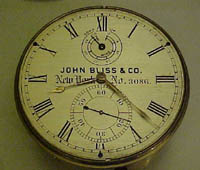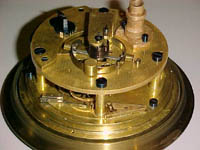

By this time the Bliss company was using movements made by London maker Victor Kullberg. This is a typical Kullburg reverse-fusee movement with a basic "Earnshaw" style balance. No auxiliary compensation was needed on a survey chronometer, and at this time the Navy no longer accepted chronometers with auxiliary compensation because of the difficulty of keeping them in adjustment. The fact that this has a steel hairspring may indicate that it was made for sale to the Navy. At this time John Bliss & Co., like some other makers, often used palladium hairsprings which are resistant to rust, magnetism, and are less affected by temperature. The Navy, however, demanded steel hairsprings on chronometers made for them. Palladium hairsprings, which are silver to white in color, were known to be softer and harder to work with than steel.
|
 |
|
|
 |
SN. 3086 c. 1911. Dial, silvered with gold hands 4 in. diameter |
The person from whom I acquired this chronometer told me it was one of six purchased from the U.S. Air Force in 1949, so I assume it was used in WWII. The original glass crystal has been replaced by a remarkably well made plexiglass crystal which is nearly indistinguishable from a glass one. Also, the screw holes used for mounting the gimbal straps (brackets used to support the chronometer in the gimbal ring) have been filled, and new holes for the break circuit wiring drilled. From the care given to this work I presume this was done by the military. A likely scenario might be that this was a Navy chronometer that was transferred to the Air Force. The plastic replacement crystal hints at a weight saving strategy for aircraft use. The break circuit wiring could also be for aircraft use.
The break circuit comprises a normally closed switch which is opened momentarily every half second except for the 59th second of every minute, to establish time. The switch is a modified spring detent similar to those used in the escapement. More specifically, it appears to be a modified Hamilton Model 21 chronometer detent, indicating the modification was done during WWII. The circuit has two connectors on the outside of the tub, one grounded to the tub, and an insulated "hot" connector (missing on this instrument).
Break circuit instruments were used for a variety of purposes. They provided master signals to control slave clocks on some ocean liners and warships. They were particularly used for geodetic surveys, and are thus known as survey chronometers. At least two John Bliss & Co. chronometers were used as the heart of automobile race timing & scoring systems produced by the Stewart Warner Co., one of which timed the Indianapolis 500 from the first race in 1911 to 1972 (it had been replaced as the primary timing system by then, but served as a backup). The Indy 500 timing system is now on display in the raceway museum. The other was owned by the chief starter of the American Automobile Association. See an article from Des Moines Capital about this timing system used in Des Moines. I presume that the Bliss chronometers so used had break circuits.
Text and some pictures copyright Norman Bliss 2002
Page created 6/20/02.
Modified 12/13/11